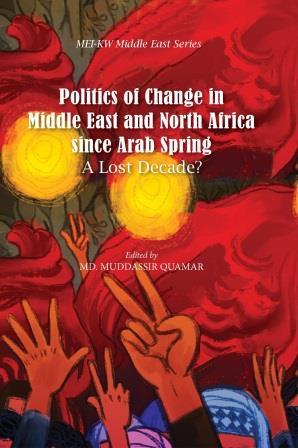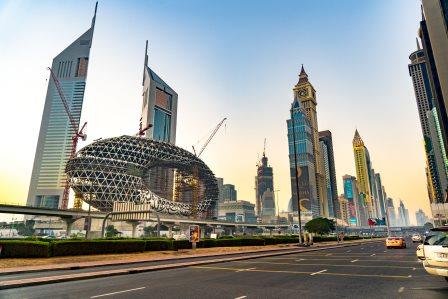Breaking
- MENU

Md. Muddassir Quamar (ed.) (2022), Politics of Change in Middle East and North Africa since Arab Spring, Knowledge World Publishers Pvt. Ltd.
When Mohammed Bouazizi, a disenchanted young Tunisian street vendor, set himself on fire in December 2010, he may not have realised that his act of protest would alter the political landscape of the Middle East and North Africa (MENA). After decades of suffering and deprivation under authoritarian regimes, the incident motivated the Arab masses to take their anger and frustration to the streets and demand justice, freedom and democracy. The autocratic rulers in Tunisia, Egypt, Libya, and Yemen relinquished their power, unable to withstand the wrath of their people. In contrast, the political elites in countries like Syria resolved to counter-revolutionary measures, triggering full-scale civil war.
It has been a decade since these popular uprisings, the Arab Spring as it is known, called for democratic transformations in the MENA region. It is crucial to retrospect whether the Arab uprisings that shook the regimes in Tunis, Cairo, Damascus, Sana’a, Tripoli and other Arab capitals a decade ago brought any significant changes to the MENA region. Did the last decade cater to the political and social aspirations of the Arab masses? Or was it a lost decade, filled with despair and chaos? The book, Politics of Change in Middle East and North Africa since Arab Spring: A Lost Decade?, edited by Md. Muddassir Quamar, addresses these questions.
This edited volume comprises sixteen chapters, contributed by distinguished scholars and practitioners of Middle Eastern studies from India and abroad. In the introductory chapter, the editor highlights some of the evolving trends since the Arab uprisings that would determine the future of MENA: demands for democratisation, the continuation of elites and structures, need for economic reorganisation, the rise of political Islam, a more significant role for women in public life, the transformation of media and communication landscape, sharpening regional geopolitical competition, and finally, the continued influence of external powers. The subsequent chapters in the book revolve around these characteristics.
The book offers in-depth country-specific case studies on the political developments since the Arab Spring uprisings. Joseph A. Kéchichian focuses on the reforms initiated by the monarchy in Saudi Arabia, especially to meet the aspirations of its youth population. While Nina Slama surveys the political developments in Tunisia following the self-immolation of Bouazizi, Joseph Alagha evaluates how the widespread displeasure against the chronic political and economic instability culminated into the 17 October WhatsApp Revolution in Lebanon.
Economic development, arms trade, technology, gender and minority issues in the post-Arab Spring era are critical themes covered in the book. To begin with, Sameena Hameed provides a quantitative analysis of Egypt’s socially regressive, real estate led growth model. Lakshmi Priya depicts how the Arab Spring uprisings accelerated the flow of arms to the conflict-prone MENA region. On the other hand, Rohit Sharma deals with the digitisation of conflict and cooperation in MENA, especially after digital platforms became instrumental in mass mobilisation during the Arab Spring uprisings. Hussian Solomon and Simone Bekker note how the patriarchal norms in Saudi Arabia and Iran infuse authoritarianism and hinder the democratic aspirations in general and women rights in particular. Maria Elizabeth Joseph assesses how the relations between the Iranian state and its Sunni minorities, especially in its Baluch and Kurdish pockets, deteriorated after the Arab Spring uprisings.
The intellectual contributions of institutions and think tanks to mitigate the consequences of the Arab uprisings is another dominant theme. Michael Barak discusses the role of Al-Azhar in Egypt in countering the radical thinking of the Muslim Brotherhood and the extremist and jihadist manifestation of Islam propounded by Al-Qaida and the Islamic State. Mona Ali sheds light on the rise of indigenous think tanks in the Gulf States and their influence on regional security. Meanwhile, Sinem Cengiz examines the changing perspective of the Arab world among Turkish intelligentsia through discourse analysis.
Finally, the book allows the readers to look at the position of external powers on the Arab Spring uprisings through a comparative lens.Krzysztof Strachota, Mordechai Chaziza, Uma Purushothaman and P.R. Kumaraswamy, respectively, provide insights on Turkish, Chinese, Russian, and Indian responses to the Arab Spring. Though the central role played by the United States is emphasised in some chapters of the book, surprisingly, there is no chapter on the American response to the uprisings. Similarly, the civil wars and resultant humanitarian crisis in Syria and Yemen and the rise of small states such as Qatar and the United Arab Emirates received minimal attention in the book. Nevertheless, the book has covered several issues that help understand the nuances of the Arab Spring uprisings and its aftermath.
The book essentially argues that no country in the Arab world exhibited any substantial change in the decade since the Arab Spring uprisings. But the book cautions the readers that the conclusions on the impact of the uprisings on the MENA region are not final as it is still evolving. For instance, the book covers some positive trends triggered by the Arab Spring in the last decade, such as the democratization process in the Arab states, impulses for economic reorganisation and growing participation of women in public spheres. These trends are incremental and may take another decade or two to reach their fullest.
In a nutshell, the book provides an all-encompassing assessment of the trends and patterns that arose from the Arab Spring uprisings and its impact on various aspects of life – political, social, economic and cultural – in the last decade. Many of these trends and patterns would continue to dominate the MENA region in the decades to come. Hence, the book suggests that the decade since the Arab Spring is merely a ‘checkpoint’ in a long-distance race.
Note: This article was originally published in Financial Express on 24 January 2022 and has been reproduced with the permission of the author. Web Link
As part of its editorial policy, the MEI@ND standardizes spelling and date formats to make the text uniformly accessible and stylistically consistent. The views expressed here are those of the author and do not necessarily reflect the views/positions of the MEI@ND. Editor, MEI@ND: P R Kumaraswamy

Irfan Ahmed Nazir is a doctoral candidate at the Centre for West Asian Studies, Jawaharlal Nehru University (JNU), New Delhi and he focuses on the national identity debates in the United Arab Emirates (UAE) and their influence on school education. He holds a master’s degree in politics and international relations from JNU and a bachelor’s degree in history, economics and political science from Christ University, Bangalore. His research interests include Middle Eastern geopolitics, the Emirati state, society and foreign policy, external actors in the Middle East, and migration and diaspora issues, with a focus on the South Asia-Gulf corridor. He tweets at @irfannazir_in.

The FIFA World Cup 2022 is all set to kick off on 20 November 2022. However, the protests against Qa.....

©MEI Exclusive On 5 September 2021, the United Arab Emirates (UAE) unveiled a new type of vi.....

Sheikh Khalifa bin Zayed al-Nahyan, the president of the United Arab Emirates (UAE) and the ruler of.....
